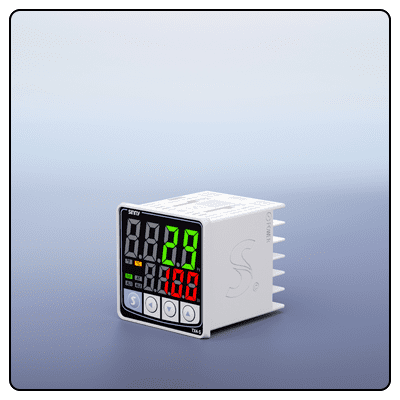Troubleshooting Tips for Common Temperature Controller Issues | Expert Guide
Discover practical troubleshooting methods for common temperature controller issues, such as irregular readings, power outages and inaccurate settings that impede optimal performance. Here you'll discover effective strategies to address such things as irregularities in readings or settings to guarantee maximum effectiveness of performance.
1. Introduction
Temperature controllers play an invaluable role in applications spanning industrial processes to home appliances, but can sometimes run into difficulties that impair their functionality. In this guide we aim to offer practical troubleshooting tips in order to identify and solve common temperature controller issues so they operate more effectively and efficiently.
2. Understanding Temperature Controllers
What Are Temperature Controllers?
Temperature controllers are devices designed to help manage and regulate the temperatures within specific environments and processes, with options like on/off, proportional, PID controllers offering different degrees of control and precision.
Basic Components
A typical temperature controller includes sensors, a control unit and an output device. Sensors detect temperature variations while processing data is being fed back through to them by way of control units before finally reaching out and changing temperatures accordingly through output devices.
Functionality and Applications.
Temperature controllers play an essential role in industries including manufacturing, food processing and scientific research. Their consistent temperature conditions help ensure high quality processes with safety as a priority.
3. Common Temperature Controller Issues Erratic Readings
Erratic Temperature Readings
An inaccurate temperature reading could be caused by either a broken sensor, environmental factors like electrical interference, or both - something which could result in inadequate control and an erosion of process quality.
Controller Is Not Powering On
Temperature controllers that won't switch on could be experiencing electrical issues or have blown fuses which require immediate attention from us as this situation could halt operations immediately and require our immediate intervention to continue functioning efficiently.
Temperature Settings inaccuracy
Accurate temperature settings could result from calibration mistakes or software bugs; such issues could compromise temperature control's precision, leading to less than optimal outcomes.
Overheating or underheating
Overheating or underheating may occur as the result of defective components or incorrect settings, necessitating quick intervention to repair equipment or products that have become compromised. This issue must be quickly rectified for optimal operation and safety purposes.

4. Troubleshooting Tips
Erratic Temperature Readings
Check Sensor Placement and Connections: Ensure the sensor is securely placed.
Calibrate Sensor: Referring to your manufacturer's manual regarding sensor calibration will help to ensure accurate readings.
Reducing Interference and Maintaining Stable Conditions For Sensor: Reduce electrical interference to create an ideal environment for sensor. Our Controller Isn't Starting
Inspection and Replacement: Verify that the power supply is operating as intended and that all connections are secure.
Test and Replace Fuses: Inspect for and replace blown fuses as necessary in order to restore power, in case they've become frayed over time.
Examine Electrical Connections: Check that all connections are undamaged and free from damage before making adjustments for temperature settings.
Incorrect Temperature Settings
Recalibrate Controller: Use the user manual as a guideline for recalibration, to ensure accurate settings on your controller.
Update Firmware: Check with your manufacturer about possible firmware upgrades that could address software-related problems and install them to ensure smooth functioning.
Verifying Settings: Double-check that all temperature settings have been properly configured in order to prevent overheating or underheating of equipment. Rather, this ensures there will be no chance for either an accidental shutdown of equipment due to overheating or underheating issues.
Check for Obstructions: Ensure there are no obstructions near the controller that could hinder its performance, and verify proper heat dissipation via adequate ventilation to avoid overheating of its circuit board.
Review Settings: Before setting sensors or connections in place for an application, double-check that their settings meet specific application specifications.
5. Maintenance Tips
Regular Inspection
For optimal sensor and connectivity performance, conduct periodic checks in order to detect issues early and resolve them swiftly before they deteriorate into more serious problems.
Software Updates
Keep the firmware and software of your controller up-to-date to take advantage of any newly available features or fixes.
Environment Control
Maintain an ideal working environment by controlling external influences and maintaining accurate temperature regulation.
6. Know When to Seek Professional Assistance
for Complex Issues
If basic troubleshooting steps fail to resolve an issue, this may signal more complex difficulties that require professional intervention.
Professional Services Hiring certified technicians who specialize in temperature controllers to analyze and repair complex issues will ensure the controller works effectively and reliably.
7. Conclusion
Recap of Key Points Regular maintenance and accurate troubleshooting are vital to ensure optimal temperature controller operation, and promptly addressing issues can prevent disruptions to control.
Encouragement Do not hesitate to seek professional help when necessary, using reliable resources as ongoing support while staying current with industry best practices.
8. FAQs
Common Queries
What steps should I take if my temperature controller displays irregular readings? Initially, examine sensor placement, calibrate its sensor, and minimize environmental interference as these can all have an effect on temperatures.
How can I fix a temperature controller that won't power on?
Check and replace fuses as necessary and ensure all electrical connections are secure.
What steps can be taken if my temperature settings are inaccurate? Recalibrate my controller, update its firmware, and verify my settings - get expert advice here
Regular Maintenance: Perform regular checks and updates in order to prevent problems from developing, whilst seeking certified technicians' help for complex problems.
- Top Benefits of Using Temperature Controllers in Your Operations
- Understanding Temperature Controllers: A Comprehensive Overview





















